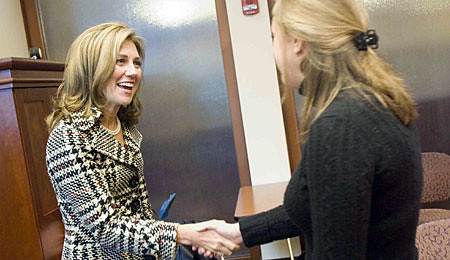New York’s first lady, Silda Wall Spitzer, visited Colgate Tuesday to learn about cooperative partnerships between local not-for-profit organizations and the university.
The visit was arranged by the Partnership for Community Development (PCD), an innovative local economic development organization that was recently recognized as a model for fostering town-gown relations in New York.
 |
| Silda Wall Spitzer greets Liz Harkins ’09 at the Coop meeting room on Tuesday. (Photo by Timothy D. Sofranko) |
The PCD is funded primarily by Colgate, the town of Hamilton, and the village of Hamilton.
Spitzer met with students and faculty members representing the Upstate Institute, the Center for Outreach, Volunteerism, and Education, and the Institute for the Creative and Performing Arts in her capacity as chair of the New York State Commission on National and Community Service.
The commission is charged with fostering volunteerism and promoting community service initiatives throughout the state. Personally, Spitzer said she is “looking for ways of pulling up volunteerism as part of our collective consciousness.”
The informal “square-table meeting” — as PCD director Jim Bays called it — was an opportunity for Colgate and the PCD to impress Spitzer with the many ways the university and community work together. Clearly, it worked.
“What you are doing is very inspiring,” said Spitzer, who then suggested that Colgate’s success connecting the university’s many resources to benefit the community can be a model for other colleges.
“Working in the community definitely gives students an investment in the area,” said Emily Katz ’09, whose work on Colgate’s Student Philanthropy Council taught her how to assess the needs of local organizations that applied for grants.
Nina Capriotti told Spitzer how her work with the Mohawk Valley Resource Center for Refugees in Utica enhanced her academic understanding of migration. “Meeting the people exposes you to the issues in greater depth, and shows you the impact of what you’re studying.”
But Matt Inbusch ’08, who spent eight weeks last summer building a database of foundations that might one day help fund the Resource Center for Independent Living in Utica, offered perhaps the best news of all.
“A number of the field school interns fell in love with living here over the summer,” he said. “Some students might even want to stay on after graduation.”